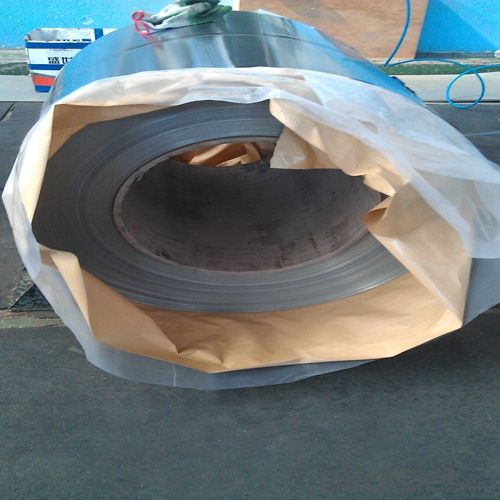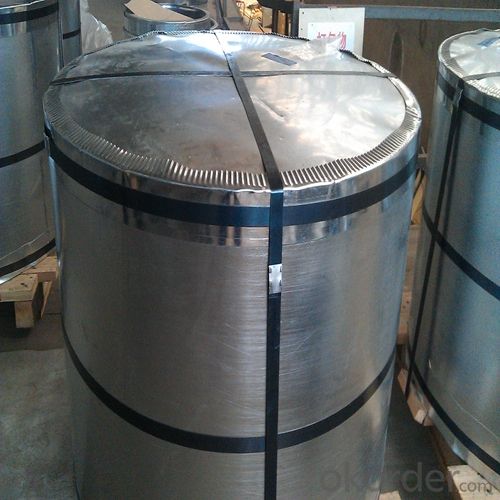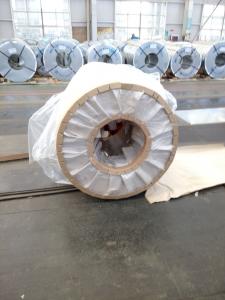Electrolytic Tinplate Coils for Useage of Chemical or Industrial Useage
- Loading Port:
- Tianjin
- Payment Terms:
- TT OR LC
- Min Order Qty:
- 50 m.t.
- Supply Capability:
- 30000 m.t./month
OKorder Service Pledge
OKorder Financial Service
You Might Also Like
Item specifice
1.Structure of Electrolytic Tinplate Coils for Useage of Chemical or Industrial Useage Description
Electrolytic Tinplate is a thin steel sheet coated by tin. It has an extremely beautiful metallic luster as well as excellent properties in corrosion resistance, solder ability, and weld ability.
2.Main Features of the Electrolytic Tinplate Coils for Useage of Chemical or Industrial Useage
Appearance – Tinplate is characterized by its beautiful metallic luster. Products with various kinds of surface roughness are produced by selecting the surface finish of the substrate steel sheet.
Paintability and printability – Tinplates have excellent paintability and printability. Printing is beautifully finished using various lacquers and inks.
Formability and strength – Tinplates have got very good formability and strength. By selecting a proper temper grade, appropriate formability is obtained for different applications as well as the required strength after forming.
Corrosion resistance – Tinplate has got good corrosion resistance. By selecting a proper coating weight, appropriate corrosion resistance is obtained against container contents. Coated items should meet 24 hour 5 % salt spray requirement.
Solderability and weldability – Tinplates can be joined both by soldering or welding. These properties of tinplate are used for making various types of cans.
Hygienic – Tin coating provides good and non toxic barrier properties to protect food products from impurities, bacteria, moisture, light and odours.
Safe – Tinplate being low weight and high strength makes food cans easy to ship and transport.
Eco friendly – Tinplate offers 100 % recyclability.
Tin is not good for low temperature applications since it changes structure and loses adhesion when exposed to temperatures below – 40 deg C.
3.Electrolytic Tinplate Coils for Useage of Chemical or Industrial Useage Images


4.Electrolytic Tinplate Coils for Useage of Chemical or Industrial Useage Specification
Specification of :
Standard: ISO 11949 -1995, GB/T2520-2000,JIS G3303,ASTM A623, BS EN 10202
Material: MR,SPCC
Thickness:0.15mm - 0.50mm
Width: 600mm -1150mm
Temper: T1-T5
Annealing: BA & CA
Coil Inner Diameter: 508mm
Weight: 6-10 tons/coil 1~1.7 tons/sheets bundle
Passivation:311
Oil: DOS
Surface: Finish,bright,stone,matte,silver
5.FAQ of Electrolytic Tinplate Coils for Useage of Chemical or Industrial Useage
- What is tinning and how does it work?
Tinning is the process of thinly coating sheets of wrought iron or steel with tin, and the resulting product is known as tinplate. It is most often used to prevent rust.
- Do you only have prime quality tinplate?
We can supply both prime and second quality tinplate.
- Q:How does tinplate packaging contribute to product marketing?
- Tinplate packaging contributes to product marketing by enhancing the visual appeal of the product, allowing for creative and attractive designs that catch the consumer's attention. It also provides a premium and durable packaging solution, creating a sense of quality and value for the product. Moreover, tinplate packaging can be customized with branding elements, logos, and product information, effectively communicating the brand's message, identity, and product attributes to the consumers. Overall, tinplate packaging plays a crucial role in influencing consumer perception, increasing brand recognition, and ultimately driving sales.
- Q:How does tinplate contribute to the protection of textile products?
- Tinplate contributes to the protection of textile products by providing a durable and corrosion-resistant packaging material. It acts as a barrier against moisture, oxygen, and light, preventing the deterioration of textile products during storage and transportation. Tinplate's protective properties help maintain the quality, color, and integrity of textiles, ensuring they reach consumers in optimal condition.
- Q:Can tinplate be used for packaging petrochemical products?
- Yes, tinplate can be used for packaging petrochemical products.
- Q:What are the main factors influencing the price of tinplate?
- There are several main factors that influence the price of tinplate. Firstly, the cost of raw materials such as tin and steel, which can fluctuate based on supply and demand dynamics, can have a significant impact on tinplate prices. Additionally, changes in labor costs, energy prices, and transportation expenses can also affect the overall price of tinplate. Furthermore, market conditions, including global economic trends, geopolitical factors, and trade policies, can influence the demand and pricing of tinplate. Lastly, technological advancements and innovations in tinplate manufacturing processes can impact production costs and subsequently affect the price of tinplate.
- Q:What are the different closure options for tinplate packaging?
- The different closure options for tinplate packaging include twist-off caps, lug caps, screw caps, and press-on caps.
- Q:Can tinplate be used for chemical packaging?
- Yes, tinplate can be used for chemical packaging. Tinplate is a material made from thin sheets of steel coated with tin, providing excellent resistance to corrosion and chemical reactions. It is commonly used for packaging sensitive chemicals, as it provides a protective barrier against moisture, oxygen, and other elements that could potentially degrade the chemicals. Additionally, tinplate is durable, lightweight, and recyclable, making it a suitable choice for chemical packaging.
- Q:How does tinplate compare to other packaging materials in terms of sustainability?
- Tinplate is considered to be a highly sustainable packaging material when compared to others. It is infinitely recyclable without losing its properties, making it a preferred choice for many industries. Tinplate also has a lower carbon footprint and energy consumption during its production compared to other packaging materials like plastic or glass. Additionally, tinplate offers excellent protection and preservation qualities, extending the shelf life of products and reducing food waste. Overall, tinplate stands out as a more environmentally friendly option in terms of sustainability in packaging.
- Q:What are the advantages of using tinplate for stationery?
- One advantage of using tinplate for stationery is its durability. Tinplate is known for its strength and resistance to corrosion, making it highly durable and long-lasting. This ensures that stationery items made from tinplate, such as pencil cases or storage tins, can withstand regular use and maintain their functionality over time. Additionally, tinplate is also a versatile material that can be easily shaped and molded into various designs, allowing for creative and aesthetically pleasing stationery products.
- Q:How does tinplate contribute to the reduction of food waste?
- Tinplate contributes to the reduction of food waste by providing a protective and durable packaging solution for various food products. Its corrosion-resistant properties ensure the longevity of the packaging, preventing spoilage and contamination. Additionally, tinplate's ability to maintain the freshness and quality of food for an extended period helps reduce waste caused by premature expiration.
- Q:How does tinplate compare to tin-free steel in terms of properties and applications?
- Tinplate and tin-free steel differ in terms of properties and applications. Tinplate has a thin tin coating on its surface, providing excellent corrosion resistance and a shiny appearance. It is commonly used in food and beverage packaging, as well as for decorative purposes. On the other hand, tin-free steel lacks the tin coating and is typically coated with other materials like chromium or polymer. It offers better paint adhesion and is often used in applications such as automotive parts, electrical appliances, and construction materials. Therefore, the choice between tinplate and tin-free steel depends on the specific requirements and intended applications.
1. Manufacturer Overview |
|
|---|---|
| Location | |
| Year Established | |
| Annual Output Value | |
| Main Markets | |
| Company Certifications | |
2. Manufacturer Certificates |
|
|---|---|
| a) Certification Name | |
| Range | |
| Reference | |
| Validity Period | |
3. Manufacturer Capability |
|
|---|---|
| a)Trade Capacity | |
| Nearest Port | |
| Export Percentage | |
| No.of Employees in Trade Department | |
| Language Spoken: | |
| b)Factory Information | |
| Factory Size: | |
| No. of Production Lines | |
| Contract Manufacturing | |
| Product Price Range | |
Send your message to us
Electrolytic Tinplate Coils for Useage of Chemical or Industrial Useage
- Loading Port:
- Tianjin
- Payment Terms:
- TT OR LC
- Min Order Qty:
- 50 m.t.
- Supply Capability:
- 30000 m.t./month
OKorder Service Pledge
OKorder Financial Service
Similar products
New products
Hot products
Hot Searches
Related keywords




























